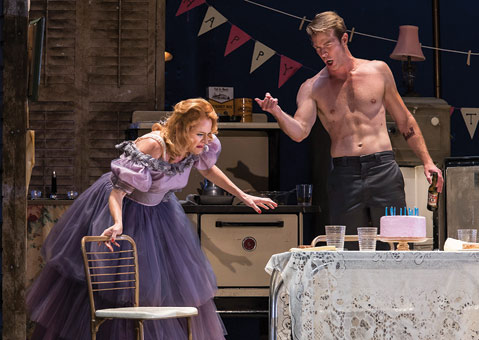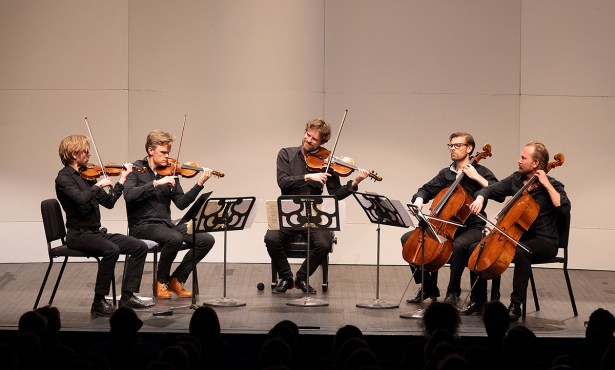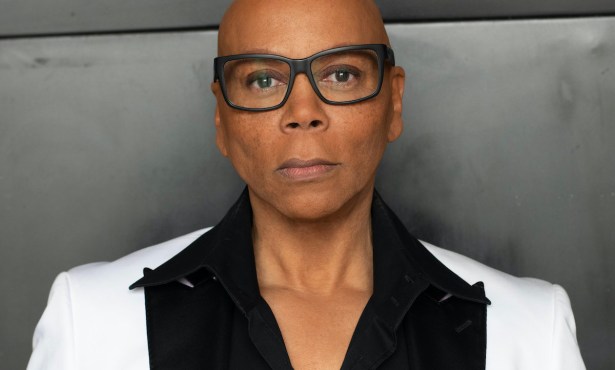Review: A Streetcar Named Desire
Presented by Opera Santa Barbara, at the Granada Theatre, Friday, April 24.

Before the music in this excellent production even began, two casually dressed cast members lounged downstage smoking cigarettes. While their efforts to render the easygoing atmosphere of working class New Orleans were effective, one couldn’t help noticing the shadows cast around them by three enormous telephone poles, one of which was set at a disturbing angle. With their cross shapes, these vertical elements in the set suggested that the audience would be observing a kind of modern Golgotha, a Calvary on which some bloody sacrifice must inevitably take place.
Less than 20 minutes later, the brilliant soprano Beverly O’Regan Thiele, as Blanche DuBois, to Micaëla Oeste’s Stella, reached the climax of their opening duet with words that defined the evening’s passion with utmost clarity and expressiveness. “Death is expensive,” Blanche proclaimed, and although in context she was defending her inability to save the pair’s ancestral home from foreclosure, the phrase, like so many others in Tennesse Williams’s great masterpiece, hung in the air as a symbol of the heroine’s great dilemma. In a society in which it seems that everything has a price, could it be that even death might someday become too expensive? What happens to someone who can’t afford to live, or even to die? A Streetcar Named Desire points the way to that particular modern version of tragedy.
This production (sets, costume, and staging) was developed in collaboration with San Francisco Opera’s Merola program and the Kentucky Opera to introduce a new “reduced” score that would make André Previn’s masterful adaptation available to smaller opera companies. It succeeds admirably in that goal, and kept the Granada audience spellbound through three hours and two intermissions.
Gregory Gerbrandt brought something new and exciting to the role of Stanley Kowalski without altering the story’s essential DNA. Casey Candebat gave a memorable performance as Harold “Mitch” Mitchell, Blanche’s sometime suitor and Stanley’s somewhat less than friend. Previn’s great achievement, beyond even the composition of so much gorgeous, accessible music, is to have captured the ensemble spirit of the original script. Rather than letting a pair of showboating leads run away with the spotlight, this opera version of what is already a highly operatic show delves deeper into the complexities and nuances of their context, rendering both Stanley and Blanche more understandable, and thus more tragic.
For example, in the infamous scene with the Newspaper Collector (Tyler Thompson), Blanche is not the sole driver in their brief flirtation. While the boy may begin by acting naïve and reluctant, in this heated-up staging, he reciprocates Blanche’s passion, leaving her no choice but to shoo him away before Mitch arrives.
For Stanley and Stella, Blanche presents an obstacle that, one way or another, has to be removed. Previn’s score for their discussion of this problem at the end of Act II deploys jazzy flutes and brass in the service of a version of Stanley’s well-known “colored lights” speech that’s more subtle and indirect than the original, yet conveys the same yearning. Additional lines underscore the implication — if Blanche’s intrusive presence represents reality, then “who wants real?”
Difficult cruxes get imaginative solutions, as Stanley yells, “Stella!” (because singing it would not work), and Blanche’s great exit line, “Whoever you are, I have always depended on the kindness of strangers,” becomes an echo phrase, not through the obvious repetition of the final words, but rather through the delicate refrain of “whoever you are,” which Blanche repeats until she has left the stage. This was certainly one of the highlights of the year in Santa Barbara and represents a promising new stage in the development of an American opera tradition for the 21st century.



